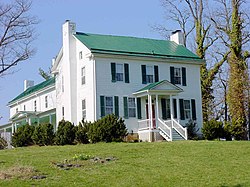
Winchester National Cemetery is a United States National Cemetery located in the city of Winchester in Frederick County, Virginia. Administered by the United States Department of Veterans Affairs, it encompasses 4.9 acres (2.0 ha), and as of the end of 2005, it had 5,561 interments. It is closed to new interments.

Staunton National Cemetery is a United States National Cemetery located in the Shenandoah Valley, in Staunton, Virginia. Administered by the United States Department of Veterans Affairs, it encompasses just over a single acre, and as of the end of 2005 had 994 interments. It is closed to new interments, and is maintained by the Culpeper National Cemetery.

The Virginia Landmarks Register (VLR) is a list of historic properties in the Commonwealth of Virginia. The state's official list of important historic sites, it was created in 1966. The Register serves the same purpose as the National Register of Historic Places. The nomination form for any Virginia site listed on the VLR is sent forward to the National Park Service for consideration for listing on the National Register.

Sayler's Creek Battlefield, near Farmville, Virginia, was the site of the Battle of Sayler's Creek of the American Civil War. Confederate general Robert E. Lee's army was retreating from the Richmond to the Petersburg line. Here, on April 6, 1865, Union general Philip Sheridan cut off and beat back about a quarter of Lee's depleted army. Eight Confederate generals surrendered, and 7,700 men were lost. Confederate Major General George Washington Custis Lee, eldest son of Robert E. Lee, was forcibly captured on the battlefield by Private David Dunnels White of the 37th Massachusetts Regiment. The battle was the last major engagement of the war in Virginia; Lee's surrender at Appomattox occurred three days later. A portion of the landmarked battlefield area is included in Sailor's Creek Battlefield Historical State Park. The Civil War Trust and its partners have acquired and preserved 885 acres (3.58 km2) of the battlefield in five transactions since 1996.
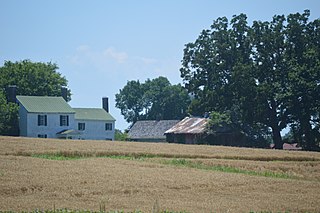
Brandon Plantation is a historic plantation home located near Alton, Halifax County, Virginia. The main house is a two-part, frame vernacular farmhouse. The earliest section of the farmhouse is a single-pile, three-bay gable-roof dwelling erected about 1800. Attached to the east end is a two-bay section added about 1842. The interior features details attributed to Thomas Day, a well-known African-American cabinetmaker from Milton, North Carolina. The farmhouse underwent an extensive remodeling and modernization in the early 1960s but preserves a significant degree of architectural integrity. Also on the property are a contributing frame kitchen / slave quarter outbuilding, an early stone-lined well, and the sites of early agricultural outbuildings.
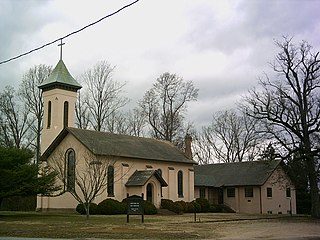
Martin's Brandon Church, also known as Brandon Church and as Martin's Brandon Episcopal Church, is a historic Episcopal church located at 18706 James River Drive in Burrowsville, Virginia. Martin's Brandon Parish was formed in the early 17th century and derives its name from the nearby Martin's Brandon Plantation patented by Captain John Martin in 1616. The current church was designed by noted Baltimore architect Niernsee & Neilson and built in 1855 as a replacement for an earlier sanctuary that once stood directly across Route 10 near the site of the Burrowsville School. Several of its beautiful stained glass windows were designed by Louis Comfort Tiffany. A cherished possession of Brandon Church is a silver communion chalice known as the "Communion Cupp" that has been used by Martin's Brandon Parish since the 17th century. The property also includes the contributing church cemetery.

Historic Sandusky is a historic home located in Lynchburg, Virginia. It is a formal two-story, brick "I" house built about 1808, with a later addition. It was built by Charles Johnston, and is one of the earliest homes in the Lynchburg area to display the architectural details and refinements characteristic of Federal design.

This is a list of the National Register of Historic Places listings in Henrico County, Virginia.

Pine Knot is a historic cabin located 14 miles (23 km) south of Charlottesville, Virginia in Albemarle County, Virginia. The cabin was owned and occupied by the 26th president of the United States, Theodore Roosevelt and his wife Edith Kermit Roosevelt, and used by Roosevelt and the first lady while he was president, although no official business took place there. In 1905, Edith Roosevelt spent $280 to purchase the fifteen-acre property with its rustic worker's cabin, and she bought an additional seventy-five acres in 1911. The cabin is owned by the Edith and Theodore Roosevelt Pine Knot Foundation and is open for visits by appointment.

First Baptist Church is a historic African-American Baptist church complex located at Covington, Virginia. The property includes two churches. One of the churches was built about 1890, and is a Gothic Revival style frame church. After construction of the 1911 church, it served as a classroom annex and cafeteria for a nearby school. The 1911 church is a Gothic Revival / Colonial Revival brick church. It features a corner belfry tower, lancet arched stained-glass windows, and a modernistic 1955 education wing.
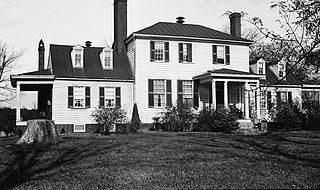
Burnt Quarter is a historic plantation house located near Dinwiddie, Dinwiddie County, Virginia. It was built in stages starting about 1750, and consists of a two-story, hipped roof central section flanked by 1+1⁄2-story wings. On April 1, 1865, the property became the scene of the decisive Battle of Five Forks. During the battle the house served both as headquarters for Union General Merritt and as a military hospital. On the grounds is a monument to six unknown Confederate soldiers killed in the Battle of Five Forks.

Waverly is a historic home and farm located near Burnt Chimney, Franklin County, Virginia. It was built beginning about 1853 for Armistead Lewis Burwell (1809-1883) and his family, who inherited it from the parents of his wife, Mary Hix (1811-1895). Descended from the First Families of Virginia, Armistead L. Burwell operated a tobacco and grain plantation of about 350 improved acres using enslaved labor, and also had a chewing tobacco factory, gristmill and sawmill by 1860. His son William A. Burwell (1836-1882) ran the factory and bought the plantation from his father in 1864, and sold it in 1868 to his younger brother John Spotswood Burwell who operated a dairy farm until after the turn of the century.
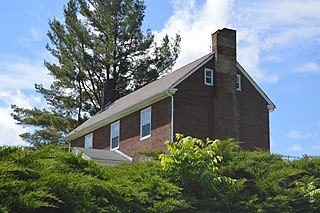
Finney–Lee House is a historic home near Snow Creek, Franklin County, Virginia. It was built in 1838–1839 and is a two-story, three-bay brick dwelling. It has a gable roof and exterior end chimneys. The interior features Federal and Greek Revival design details. Also on the property are the contributing front walkway, pack house, two tobacco barns, a cemetery, and a road trace.

Brooklyn Tobacco Factory, also known as the Hightower & Barksdale Tobacco Factory, is a historic tobacco factory located at Brooklyn, Halifax County, Virginia. It was built about 1855, and is a two-story, brick building with a gable roof. It features brick chimney flues projecting above the metal sheathed roof. Also on the property are two contributing pack houses and the ruins of a log house. The factory was designed and built by Dabney Cosby, Jr., son of the Jeffersonian workman, Dabney Cosby, Sr. The factory remained in operation until 1881.

Grassdale Farm is a historic home located at Spencer, Henry County, Virginia. It was built about 1860, and is a two-story, center-passage-plan frame dwelling with Greek Revival and Greek Revival style influences. Two-story ells have been added to the rear of the main section, creating an overall "U" form. Also on the property are a variety of contributing buildings and outbuildings including a kitchen, smokehouse, cook's house, log dwelling, and office / caretaker's house dated to the 19th century; and a garage, playhouse, poultry house, two barns, greenhouse, Mack Watkin's House, granary and corn crib, and Spencer Store and Post Office dated to the 1940s-1950s. Grassdale Farm was once owned by Thomas Jefferson Penn, who built Chinqua-Penn Plantation outside Reidsville, North Carolina, where the Penn tobacco-manufacturing interests were located.
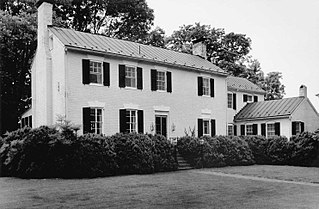
Hare Forest Farm is a historic home and farm complex located near Orange, Orange County, Virginia, United States. The main house was built in three sections starting about 1815. It consists of a two-story, four-bay, brick center block in the Federal style, a two-story brick dining room wing which dates from the early 20th century, and a mid-20th-century brick kitchen wing. Also on the property are the contributing stone garage, a 19th-century frame smokehouse with attached barn, an early-20th-century frame barn, a vacant early-20th-century tenant house, a stone tower, an early-20th-century frame tenant house, an abandoned storage house, as well as the stone foundations of three dwellings of undetermined date. The land was once owned by William Strother, maternal grandfather of Zachary Taylor, and it has often been claimed that the future president was born on the property.

Margaret E. Poague House is a historic home located near Lexington, Rockbridge County, Virginia. It was built about 1847, and is a two-story, three-bay Greek Revival style brick dwelling. It sits banked into a hillside and has a standing seam metal gable roof and interior end chimneys. The property also includes a contributing early-20th century gate pillar.
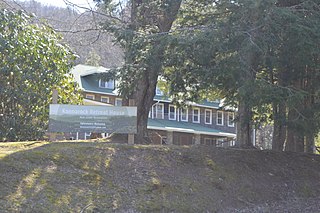
Konnarock Training School, also known as Konnarock Lutheran Girls School, is a historic school complex located at Konnarock, Smyth County, Virginia. The main building was built in 1925, and is a 2+1⁄2-story, 14 bay, hipped roof, Rustic style wood-frame building. It is sheathed in bark shingles and has an attached rear chapel. Also on the property are an American Craftsman-style chestnut bark-shingled bungalow (1936) originally used as the school's Health Center, a collapsed two-car garage, an arbor and a farm complex. The property was original developed by the Lutheran church as a mission to the southern Appalachians. The school closed in 1958, and was later acquired by the Forest Service.

Old Roanoke County Courthouse is a historic courthouse building located in Salem, Virginia. It was built in 1909-1910 and is a three-story, Classical Revival-style, yellow brick building. The front façade features a three-story, tetra-style Ionic order portico. The courthouse has a hipped roof topped by a cupola, which is topped by an eagle. A rear addition was built in 1948–1949. The building housed Roanoke County, Virginia county offices until they moved to a new building in 1985.

Hawthorne and Old Town Spring is a historic home and spring located at Winchester, Virginia, United States. Hawthorne was built about 1811, and is a two-story, five-bay, Late Georgian style stone dwelling with Federal style detailing. It has a hipped roof and rear service wing added about 1840. The Old Town Spring is a brick spring house built about 1816. Also on the property are contributing stone entry gateposts and walls and a stone garage built about 1915. The spring and the early-19th-century spring house that rests above it have been owned by the City for nearly 175 years.
